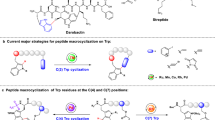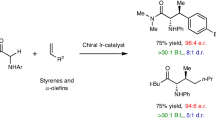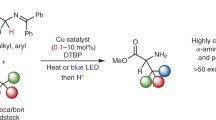Abstract
This protocol provides a detailed procedure for the preparation of stapled α-helical peptides, which have proven their potential as useful molecular probes and as next-generation therapeutics. Two crucial features of this protocol are (i) the construction of peptide substrates containing hindered α-methyl, α-alkenyl amino acids and (ii) the ring-closing olefin metathesis (RCM) of the resulting resin-bound peptide substrates. The stapling systems described in this protocol, namely bridging one or two turns of an α-helix, are highly adaptable to most peptide sequences, resulting in favorable RCM kinetics, helix stabilization and promotion of cellular uptake.
This is a preview of subscription content, access via your institution
Access options
Subscribe to this journal
Receive 12 print issues and online access
$259.00 per year
only $21.58 per issue
Buy this article
- Purchase on Springer Link
- Instant access to full article PDF
Prices may be subject to local taxes which are calculated during checkout






Similar content being viewed by others
References
Verdine, G.L. & Walensky, L.D. The challenge of drugging undruggable targets in cancer: lessons learned from targeting BCL-2 family members. Clin. Cancer Res. 13, 7264–7270 (2007).
Mimna, R., Tuchscherer, G. & Mutter, M. Toward the design of highly efficient, readily accessible peptide N-caps for the induction of helical conformations. Int. J. Pept. Res. Ther. 13, 237–244 (2007).
Henchey, L.K., Jochim, A.L. & Arora, P.S. Contemporary strategies for the stabilization of peptides in the alpha-helical conformation. Curr. Opin. Chem. Biol 12, 692–697 (2008).
Schafmeister, C.E., Po, J. & Verdine, G.L. An all-hydrocarbon cross-linking system for enhancing the helicity and metabolic stability of peptides. J. Am. Chem. Soc. 122, 5891–5892 (2000).
Blackwell, H.E. & Grubbs, R.H. Highly efficient synthesis of covalently crosslinked peptide helices by ring-closing metathesis. Angew. Chem. Int. Ed. 37, 3281–3284 (1998).
Walensky, L.D. et al. Activation of apoptosis in vivo by a hydrocarbon-stapled BH3 helix. Science 305, 1466–1470 (2004).
Bhattacharya, S., Zhang, H.T., Debnath, A.K. & Cowburn, D. Solution structure of a hydrocarbon stapled peptide inhibitor in complex with monomeric C-terminal domain of HIV-1 capsid. J. Biol. Chem. 283, 16274–16278 (2008).
Zhang, H. et al. A cell-penetrating helical peptide as a potential HIV-1 inhibitor. J. Mol. Biol. 378, 565–580 (2008).
Bernal, F., Tyler, A.F., Korsmeyer, S.J., Walensky, L.D. & Verdine, G.L. Reactivation of the p53 tumor suppressor pathway by a stapled p53 peptide. J. Am. Chem. Soc. 129, 2456–2457 (2007).
Danial, N.N. et al. Dual role of proapoptotic BAD in insulin secretion and beta cell survival. Nat. Med. 14, 144–153 (2008).
Gavathiotis, E. et al. BAX activation is initiated at a novel interaction site. Nature 455, 1076–1081 (2008).
Moellering, R.E. et al. Direct inhibition of the NOTCH transcription factor complex. Nature 462, 182–188 (2009).
Stewart, M.L., Fire, E., Keating, A.E. & Walensky, L.D. The MCL-1 BH3 helix is an exclusive MCL-1 inhibitor and apoptosis sensitizer. Nat. Chem. Biol. 6, 595–601 (2010).
Bird, G.H. et al. Hydrocarbon double-stapling remedies the proteolytic instability of a lengthy peptide therapeutic. Proc. Natl. Acad. Sci. USA 107, 14093–14098 (2010).
Walensky, L.D. et al. A stapled BID BH3 helix directly binds and activates BAX. Mol. Cell 24, 199–210 (2006).
Bernal, F. et al. A stapled p53 helix overcomes HDMX-mediated suppression of p53. Cancer Cell. 18, 411–422 (2010).
Kim, Y.W., Kutchukian, P.S. & Verdine, G.L. Introduction of all-hydrocarbon i,i+3 staples into alpha-helices via ring-closing olefin metathesis. Org. Lett. 12, 3046–3049 (2010).
Kim, Y.W. & Verdine, G.L. Stereochemical effects of all-hydrocarbon tethers in i,i+4 stapled peptides. Bioorg. Med. Chem. Lett. 19, 2533–2536 (2009).
Williams, R.M. & Im, M.N. Asymmetric-synthesis of monosubstituted and alpha,alpha-disubstituted alpha-amino-acids via diastereoselective glycine enolate alkylations. J. Am. Chem. Soc. 113, 9276–9286 (1991).
Belokon, Y.N., Tararov, V.I., Maleev, V.I., Savel'eva, T.F. & Ryzhov, M.G. Improved procedures for the synthesis of (S)-2-[N-(N′-benzylprolyl)amino]benzophenone (BPB) and Ni(II) complexes of Schiff's bases derived from BPB and amino acids. Tetrahedron: Asymmetry 9, 4249–4252 (1998).
Qiu, W., Soloshonok, V.A., Cai, C.Z., Tang, X.J. & Hruby, V. Convenient, large-scale asymmetric synthesis of enantiomerically pure trans-cinnamylglycine and -alpha-alanine. Tetrahedron 56, 2577–2582 (2000).
Bird, G.H., Bernal, F., Pitter, K. & Walensky, L.D. Synthesis and biophysical characterization of stabilized alpha-helices of BCL-2 domains. in Programmed Cell Death, The Biology and Therapeutic Implications of Cell Death, Part B. Methods Enzymol. 446, 369–386 (2008).
Berman, H.M. et al. The Protein Data Bank. Nucleic Acids Res. 28, 235–242 (2000).
Marder, O., Shvo, Y. & Albericio, F. HCTU and TCTU. New coupling reagents: development and industrial aspects. Chim. Oggi-Chem. Today 20, 37–41 (2002).
Sabatino, G. et al. Assessment of new 6-Cl-HOBt based coupling reagents for peptide synthesis. Part 1: coupling efficiency study. Lett. Pept. Sci. 9, 119–123 (2002).
Hood, C.A. et al. Fast conventional Fmoc solid-phase peptide synthesis with HCTU. J. Pept. Sci. 14, 97–101 (2008).
Subiros-Funosas, R. et al. PyClocK, the phosphonium salt derived from 6-Cl- HOBt. Chim. Oggi-Chem. Today 26, 10–12 (2008).
Carpino, L.A. 1-hydroxy-7-azabenzotriazole—an efficient peptide coupling additive. J. Am. Chem. Soc. 115, 4397–4398 (1993).
Albericio, F., Bofill, J.M., El-Faham, A. & Kates, S.A. Use of onium salt-based coupling reagents in peptide synthesis. J. Org. Chem. 63, 9678–9683 (1998).
Boal, A.K. et al. Facile and E-selective intramolecular ring-closing metathesis reactions in 3(10)-helical peptides: a 3D structural study. J. Am. Chem. Soc. 129, 6986–6987 (2007).
Chapman, R.N., Dimartino, G. & Arora, P.S. A highly stable short alpha-helix constrained by a main-chain hydrogen-bond surrogate. J. Am. Chem. Soc. 126, 12252–12253 (2004).
Chapman, R.N. & Arora, P.S. Optimized synthesis of hydrogen-bond surrogate helices: surprising effects of microwave heating on the activity of Grubbs catalysts. Org. Lett. 8, 5825–5828 (2006).
Toniolo, C., Crisma, M., Formaggio, F. & Peggion, C. Control of peptide conformation by the Thorpe-Ingold effect (C-alpha-tetrasubstitution). Biopolymers 60, 396–419 (2001).
Urnes, P. & Doty, P. Optical rotation and the conformation of polypeptides and proteins. Adv. Protein Chem. 16, 401–544 (1961).
Sohma, Y., Sasaki, M., Hayashi, Y., Kimura, T. & Kiso, Y. Novel and efficient synthesis of difficult sequence-containing peptides through O-N intramolecular acyl migration reaction of O-acyl E isopeptides. Chem. Commun. 124–125 (2004).
Johnson, T., Quibell, M., Owen, D. & Sheppard, R.C. A reversible protecting group for the amide bond in peptides—use in the synthesis of difficult sequences. J. Chem. Soc. Chem. Commun. 369–372 (1993).
Haack, T. & Mutter, M. Serine derived oxazolidines as secondary structure disrupting, solubilizing building-blocks in peptide-synthesis. Tetrahedron Lett. 33, 1589–1592 (1992).
Lauer, J.L., Fields, C.G. & Fields, G.B. Sequence dependence of aspartimide formation during 9-fluorenylmethoxycarbonyl solid-phase peptide synthesis. Lett. Pept. Sci. 1, 197–205 (1994).
Crabb, J.W., West, K.A., Dodson, W.S. & Hulmes, J.D. Amino acid analysis. Curr. Protoc. Protein Sci. 11.9.42 (2001).
Gasteiger, E. et al. Protein identification and analysis tools on the ExPASy server. in The Proteomics Protocols Handbook (ed. Walker, J.M.) 571–607 (Humana Press, 2005).
Acknowledgements
This research was supported by the Harvard and Dana-Farber Program in Cancer Chemical Biology. T.N.G. is grateful for a fellowship from Deutsche Akademie der Naturforscher Leopoldina (LPDS 2009-2).
Author information
Authors and Affiliations
Contributions
G.L.V. directed the research and, with Y.-W.K., conceptualized the experiments. Y.-W.K. performed the experiments. All authors discussed the results and wrote the manuscript.
Corresponding author
Ethics declarations
Competing interests
G.L.V. is a shareholder in and a paid consultant of Aileron Therapeutics, which has been granted a license from Harvard University and the Dana-Farber Cancer Institute to develop the stapled peptide technology.
Rights and permissions
About this article
Cite this article
Kim, YW., Grossmann, T. & Verdine, G. Synthesis of all-hydrocarbon stapled α-helical peptides by ring-closing olefin metathesis. Nat Protoc 6, 761–771 (2011). https://doi.org/10.1038/nprot.2011.324
Published:
Issue Date:
DOI: https://doi.org/10.1038/nprot.2011.324
This article is cited by
-
Design-rules for stapled peptides with in vivo activity and their application to Mdm2/X antagonists
Nature Communications (2024)
-
Recognition and reprogramming of E3 ubiquitin ligase surfaces by α-helical peptides
Nature Communications (2023)
-
Targeting MYC with modular synthetic transcriptional repressors derived from bHLH DNA-binding domains
Nature Biotechnology (2023)
-
Effect of substituting glutamine with lysine on structural and biological properties of antimicrobial peptide Polybia-MP1
Amino Acids (2023)
-
A Review of the in Silico Design and Development Approaches of Ras-Specific Anticancer Therapeutics
International Journal of Peptide Research and Therapeutics (2023)
Comments
By submitting a comment you agree to abide by our Terms and Community Guidelines. If you find something abusive or that does not comply with our terms or guidelines please flag it as inappropriate.



